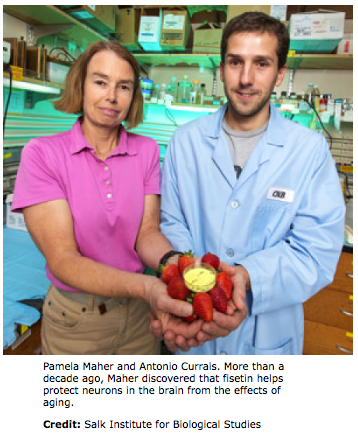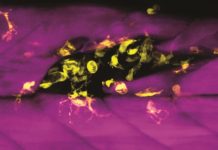 Ongoing investigations conducted in the Salk Institute’s Cellular Neurobiology Laboratory (CNL) have shown that fisetin, a naturally-occurring antioxidant flavonoid found in fruits and vegetables such as strawberries and cucumbers, can lessen the complications of diabetes. Previously, the lab had shown how fisetin promoted survival of neurons grown in culture and enhanced memory in healthy mice.
Ongoing investigations conducted in the Salk Institute’s Cellular Neurobiology Laboratory (CNL) have shown that fisetin, a naturally-occurring antioxidant flavonoid found in fruits and vegetables such as strawberries and cucumbers, can lessen the complications of diabetes. Previously, the lab had shown how fisetin promoted survival of neurons grown in culture and enhanced memory in healthy mice.
Pam Maher, Ph.D., a senior staff scientist in the CNL, initially identified fisetin as a neuroprotective flavonoid ten years ago. “In plants, flavonoids act as sunscreens and protect leaves and fruit from insects,” she explains. “As foods they are implicated in the protective effect of the ‘Mediterranean Diet.'”
Although her group’s focus is neurobiology, Maher and colleagues reasoned that, like other flavonoids, fisetin might reduce the spectrum of disorders seen in diabetic patients. To test this, they evaluated effects of fisetin supplementation in Akita mice, a very robust animal model of type 1 diabetes.
Akita mice exhibit increased blood sugar typical of type 1 diabetes and display common symptoms of serious human complications of both type 1 and 2 diabetes, including diabetic nephropathy, kidney disease, retinopathy, and neuropathies in which patients lose touch or heat sensations.
Mice fed a fisetin-enriched diet remained diabetic, but acute kidney enlargement (hypertrophy) typically seen in untreated mice was reversed. Additionally, high urine protein levels, a sure sign of kidney disease, declined. Moreover, fisetin ingestion reduced anxiety-related behaviors in diabetic mice. “Most mice put in a large area become exploratory,” says Maher. “But anxious mice tend not to move around. Akita mice showed enhanced anxiety behavior, but fisetin feeding restored their locomotion to more normal levels.”
Early studies defined a likely molecular mechanism underlying these effects. Researchers observed that blood and brain levels of sugars affixed to proteins known as advanced glycation end-products (AGEs) were reduced in fisetin-treated mice compared to untreated Akita mice. These decreases were accompanied by increased activity of an enzyme, glyoxalase 1, that promotes the removal of toxic AGE precursors.
The discovery that fisetin increases this AGE-reducing enzyme is significant, because high blood AGE levels are associated with many, if not most, diabetic complications. “We know that fisetin increases activity of the glyoxalase enzyme and may increase its expression,” says Maher. “But what is important is that ours is the first report that any compound can enhance glyoxalase 1 activity.”
Interestingly, excessively high AGE levels are also linked with inflammatory activity thought to promote some cancers. In fact, studies published by others confirm that fisetin decreases growth of prostate cancer cells both in culture and in animal models, which if supported would represent a major added incentive to eat your strawberries!
Reducing Alzheimer’s Related Memory Loss in Mice
In the most recent study, published in the December 17, 2013, issue of the journal Aging Cell, Maher and her team now report that fisetin also appears to stop memory loss in mice with Alzheimer’s disease. In experiments on mice that normally develop Alzheimer’s symptoms less than a year after birth, daily ingestion of fisetin prevented progressive memory and learning impairments. And though the compound did not alter the formation of amyloid plaques – the misfolded proteins that accumlate in the brain which are commonly blamed for Alzheimer’s disease – the new findings suggests a new way to treat Alzheimer’s symptoms independently of targeting amyloid plaques.
“We had already shown that in normal animals, fisetin can improve memory,” says Pamela Maher, a senior staff scientist in Salk’s Cellular Neurobiology Laboratory who led the new study. “What we showed here is that it also can have an effect on animals prone to Alzheimer’s.”
More than a decade ago, Maher discovered that fisetin helps protect neurons in the brain from the effects of aging. She and her colleagues have since revealed how the compound exerts both antioxidant and anti-inflammatory effects on cells in the brain. Most recently, they found that fisetin turns on a cellular pathway known to be involved in memory.
“What we realized is that fisetin has a number of properties that we thought might be beneficial when it comes to Alzheimer’s,” says Maher.
So Maher – who works with Dave Schubert, the head of the Cellular Neurobiology Lab – turned to a strain of mice that have mutations in two genes linked to Alzheimer’s disease. The researchers took a subset of these mice and, when they were only three months old, began adding fisetin to their food. As the mice aged, the researchers tested their memory and learning skills with water mazes. By nine months of age, mice that hadn’t received fisetin began performing more poorly in the mazes. Mice that had gotten a daily dose of the compound, however, performed as well as normal mice, at both nine months and a year old.
“Even as the disease would have been progressing, the fisetin was able to continue preventing symptoms,” Maher says.
In collaboration with scientists at the University of California, San Diego, Maher’s team next tested the levels of different molecules in the brains of mice that had received doses of fisetin and those that hadn’t. In mice with Alzheimer’s symptoms, they found that pathways involved in cellular inflammation were turned on. In the animals that had taken fisetin, those pathways were dampened and anti-inflammatory molecules were present instead. One protein in particular – known as p35 – was blocked from being cleaved into a shorter version when fisetin was taken. The shortened version of p35 is known to turn on and off many other molecular pathways.
Studies on isolated tissue had hinted that fisetin might also decrease the number of amyloid plaques in Alzheimer’s affected brains. However, that observation didn’t hold up in the mice studies. “Fisetin didn’t affect the plaques,” says Maher. “It seems to act on other pathways that haven’t been seriously investigated in the past as therapeutic targets.”
Next, Maher’s team hopes to understand more of the molecular details on how fisetin affects memory, including whether there are targets other than p35.
“It may be that compounds like this that have more than one target are most effective at treating Alzheimer’s disease,” says Maher, “because it’s a complex disease where there are a lot of things going wrong.”
They also aim to develop new studies to look at how the timing of fisetin doses affect its influence on Alzheimer’s.
“The model that we used here was a preventive model,” explains Maher. “We started the mice on the drugs before they had any memory loss. But obviously human patients don’t go to the doctor until they are already having memory problems.” So the next step in moving the discovery toward the clinic, she says, is to test whether fisetin can reverse declines in memory once they have already appeared.
Source: Antonio Currais, Marguerite Prior, Richard Dargusch, Aaron Armando, Jennifer Ehren, David Schubert, Oswald Quehenberger, Pamela Maher. Modulation of p25 and inflammatory pathways by fisetin maintains cognitive function in Alzheimer’s disease transgenic mice. Aging Cell, 2013; DOI: 10.1111/acel.12185














